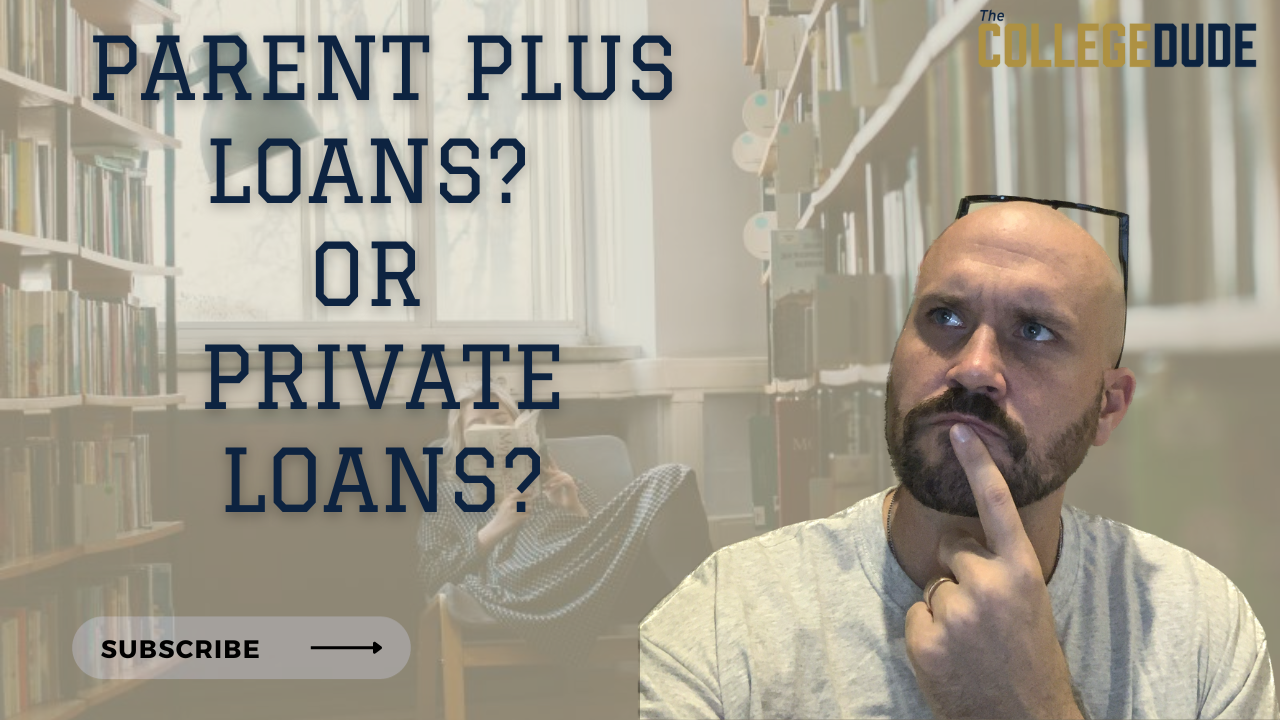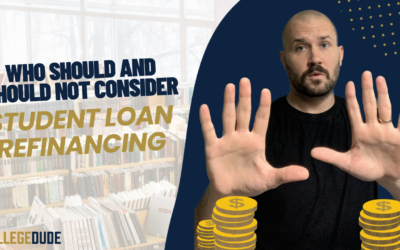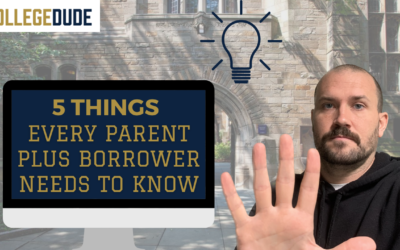When it comes to financing a college education, parents often face a daunting decision. Whether to opt for a Parent PLUS or private loans, perhaps with the parent as a cosigner, looms large. This decision entails weighing the pros and cons of each option. In this post, we aim to shed light on these differences to help you make an informed choice.
To begin, let’s explore the fundamental distinctions between Parent PLUS Loans and private loans. Parent PLUS Loans are exclusively in the parent’s name. They’re issued direct from the Department of Education. Meanwhile, private loans will vary greatly – issued by a bevy of financial institutions. Of note, these can be taken out in the parent’s name only, but are most often in the child’s name. Understanding these foundational differences is the first step in navigating this crucial financial decision.
Who Takes Out the Loans?
In most cases, if private loans are in the child’s name, a cosigner is almost always required. This is because private loans typically demand some level of credit history. More often than not, the child hasn’t an established credit history. As a result, many students require a cosigner, especially if they’re just starting to build their credit.
Parent PLUS Loans, on the other hand, exclude the child from any direct involvement. The responsibility solely rests on the parent’s shoulders. While you can make an agreement with your child for them to help with repayment, legally, there is no requirement for the child to repay the loan. The child’s only potential involvement would occur if there’s a consideration to transfer from a Parent PLUS Loan to a private loan in the child’s name. However, this transition can be complex, and it’s not always the recommended course of action.
It’s crucial to approach the idea of transferring from a Parent PLUS Loan to a private loan with caution. This isn’t a decision to rush into. It requires careful consideration of various factors and ensuring that all necessary criteria are met before proceeding.
Parent PLUS Loan Considerations
One noteworthy advantage is that they can cover the full cost of the child’s education. This becomes particularly relevant when parents identify a gap between available scholarships, grants, and other student loans and the total cost of attendance. In such cases, Parent PLUS Loans can help bridge that financial divide.
However, it’s important to exercise prudence in this approach. Taking out larger loans in the parent’s name without a clear repayment strategy can potentially lead to financial challenges down the road. It’s crucial to assess your financial capacity and plan accordingly when considering Parent PLUS Loans. This can help ensure a manageable financial future for both parent and child.
PLUS Loan Public Service Loan Forgiveness
That’s precisely why being part of the federal repayment system is crucial. Within this system, you can leverage various benefits. These include access to income-driven repayment plans and, if eligible, the coveted Public Service Loan Forgiveness (PSLF) program.
Income-driven repayment plans are available for all federal loans, providing some level of loan forgiveness based on your income. However, if applying for PSLF, the loan and the qualifying employment must be in the parent’s name, not the child’s. This means that the parent must be employed by an eligible employer and take the responsibility of certifying their income annually to remain on track for PSLF. It’s a valuable opportunity for parents seeking loan forgiveness while working in public service roles.
Private Loan Forgiveness Considerations
When it comes to private loans, the prospect of forgiveness programs is a rarity. While some state agencies may offer forgiveness plans, they are often limited in availability and usually come with specific requirements. This could include working for a qualifying employer at potentially lower salaries. The College Investor offers a great resource of state forgiveness programs.
Pennsylvania, for example, has 2 programs offered through the state.
It’s important to stress that taking out a private loan with the intent of pursuing loan forgiveness is generally not advisable. Private loan forgiveness is both unlikely and has specific criteria.
Terms of the Loans
Parent PLUS Loans offer more flexibility in terms of capacity to borrow. These loans allowing you to cover up to the full cost of attendance for your child’s education. Private loans, meanwhile, can vary significantly. Much depends on the creditworthiness and the lending institution’s willingness to offer loans up to the total cost of attendance. If you have a strong credit profile, you may be able to secure a private loan for the required amount, providing another avenue for financing your child’s education.
Interest Rate Considerations
Distinguishing between Parent PLUS Loans and private loans involves considering several critical factors. One major one is the interest rate.
Parent PLUS Loans feature an interest rate based on the 10-year Treasury note, with an additional percentage added. For the 2023-2024 school year, the interest rate on Parent PLUS Loans is set at 8.05%.
Private loan interest rates vary based on the creditworthiness of the student and, if applicable, the cosigner. These rates are also influenced by the prevailing interest rates at the time, such as the 10-year Treasury note.
Notably, private loans can offer either lower and higher interest rates compared to Parent PLUS Loans. One crucial difference, however, is that Parent PLUS Loans come with fixed interest rates, providing predictability in your repayment terms. This aspect can be a key factor in your decision-making process.
Private loans offer flexibility in terms of interest rates, which can either be variable or fixed. It’s crucial you read the terms outlined in the promissory note and the lending institution’s conditions.
Discharge Options
As previously discussed, another significant aspect to consider is the set of protections associated with federal loans versus private loans. Private loan protections are typically detailed in the promissory note, and you should review them carefully. One critical aspect to pay attention to is how the loan handles situations of total disability or death.
In the event of total disability or death, as defined by the Department of Education, Parent PLUS Loans are discharged. This discharge applies either upon the death of the parent borrower or the child. It’s essential to recognize that in the unfortunate event of a tragedy, Parent PLUS Loan debt can be entirely wiped away, providing a degree of financial relief and peace of mind.
Forgiveness options for private loans vary and depend on the specific terms outlined in the promissory note. Unlike federal loans, private loans typically do not offer standardized forgiveness programs. Any potential forgiveness opportunities for private loans are generally governed by state agencies. Therefore, understanding the terms and conditions of forgiveness in your state of residence is crucial. Typically, you won’t find readily available forgiveness options outlined within the promissory note of private loans.
Repayment Considerations
One significant distinction between Parent PLUS Loans and Private Loans is their repayment options. Parent PLUS Loans fall under the direct loan category, making them eligible for various direct repayment plans. These include graduated, standard, and income-driven repayment plans. Borrowers can explore options such as income-contingent repayment or income-driven repayment, depending on their circumstances and eligibility, including the possibility of utilizing the double consolidation strategy. This flexibility in repayment strategies can be a crucial factor to consider when choosing between the two loan types.
Private loans typically offer repayment terms in 5, 10, or 15-year increments. These loans often provide the flexibility to defer some payments until the child’s graduation or shortly thereafter. For those utilizing the consolidation strategy with federal loans, it may be possible to continue pausing repayments, providing a degree of flexibility.
After the grace period and forbearance periods end, borrowers will need to start repaying their loans. For private loans, refinancing options may be available, but these can vary depending on the lender. The specifics of repayment and refinancing should be explored with your private loan provider.
Credit & Qualification Considerations
In terms of the application process, Parent PLUS Loans are generally easier to apply for and do not require the same level of scrutiny as private loans. Private student loans typically undergo a creditworthiness assessment. Similar to most other personal loans, the lending institution evaluates your credit history. This means that private loan approval will be contingent on your creditworthiness defined by the financial institution.
For eligiblity for a Parent PLUS Loan, a primary requirement is that you do not have an adverse credit history. The Department of Education’s website provides the exact definition of what constitutes an adverse credit history, along with the criteria used to determine your eligibility for a Parent PLUS Loan. Checking these details is essential for understanding your qualification status.
Credit Reporting
When comparing Parent PLUS Loans and private loans, one factor is what shows up on the credit report.
With a Parent PLUS Loan, the loan is solely in the parent’s name. These loans will appear in the parent’s credit report. In contrast, private loans offer flexibility, where either the parent or the child can be the primary borrower, with the other acting as a cosigner.
Regardless of whether you are the primary borrower or cosigner on a private loan, the debt will appear on your credit report, emphasizing the importance of responsible repayment for both parties involved.
In the case of private loans with a cosigner, it’s important to note that you are not legally responsible for repayment until the primary borrower defaults. If the primary borrower does default on the loan, the responsibility would then shift to you, and you would be required to make the payments. Therefore, it’s advisable for any borrower, whether a parent or a child, to carefully assess the expected monthly repayment upon graduation. Keep in mind that interest accrues over the years, and while forbearance might be an option, understanding your future financial commitments is crucial.
Final Considerations
Considering the type of loan you choose is pivotal, as it can significantly impact your repayment plan. Furthermore, it’s essential to be aware of the differences between federal loan protections and private loans. Federal protections, including Public Service Loan Forgiveness and various repayment options, offer substantial benefits. However, it’s worth noting that Parent PLUS Loans may come with a higher interest rate and origination fee compared to some private loan options. Understanding the trade-offs between these factors is essential for making an informed decision.
The actual amount of interest repaid depends on various factors, including the repayment strategies chosen by parents and their professions, which can significantly influence the decision between private loans and Parent PLUS Loans.
Another crucial consideration is the loan balance itself. Smaller loan balances may make private loans a suitable choice, while Parent PLUS Loans could be more appropriate for larger balances, not only from the cost of attendance perspective but also in terms of income-driven repayment options and potential forgiveness opportunities.
It’s essential to emphasize the importance of having a well-thought-out plan for college financing, including how repayments will work. Student loan debt is a concern for both parents and students across generations, impacting financial goals. By educating yourself and developing a comprehensive debt strategy, you can navigate the college journey while safeguarding your long-term financial objectives.






